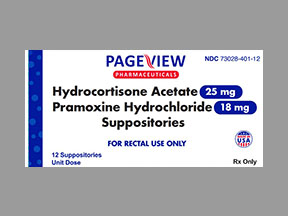
Hydrocortisone Ace-pramoxine Coupons & Savings Card – Discount Prices from $410.74
Generic for: Analpram-hc, Procort, Analpram hc
My prescription
Edit
25-18MG, Hydrocortisone Ace-pramoxine (12 Suppositories)
Select pharmacy

CVS
$425.38
COUPON PRICE
Walmart
$410.74
COUPON PRICE
Walgreens
$421.73
COUPON PRICE
Albertsons
$432.22
COUPON PRICEHydrocortisone Ace-pramoxine savings card
Show this card to your pharmacist
Walmart
$410.74
BIN
ID
PCN
GRP
019876
LH525CA848
CHIPPO
LHX
Powered by
More prescriptions for hemorrhoids
More prescriptions for hemorrhoids
Price history for Analpram-hc (brand) & Hydrocortisone Ace-pramoxine (generic)
12 Suppositories, 25-18MG
Average retail price for Analpram-hc
Average retail price for Hydrocortisone Ace-pramoxine
Average SaveHealth price for Hydrocortisone Ace-pramoxine
Our price history data is based on aggregated prescription data collected from participating pharmacies in America. Our prescription data updates daily to reflect the latest price changes. If you notice a missing data point, it means there wasn't sufficient data available to generate a monetary value for that date.
We analyzed Hydrocortisone Ace-pramoxine prices for (25-18MG, 12 Suppositories) over the last 12 months. The average retail price was $513.43, while the average price using the SaveHealth discount card was $434.00. That's a savings of approximately 15.47% when using our Hydrocortisone Ace-pramoxine coupon.
Compared to the generic version, Analpram-hc had an average price of $401.24 over the same time period. With the SaveHealth savings card, Hydrocortisone Ace-pramoxine is -8.16% cheaper on average than Analpram-hc.
*Retail prices are based on pharmacy claims data, and may not be accurate when we don't have enough claims.
Hydrocortisone Ace-pramoxine dosage forms
Dosage Quantity Price from Per unit 25-18MG 12 Suppositories $410.74 $34.23
| Dosage | Quantity | Price from | Per unit |
|---|---|---|---|
| 25-18MG | 12 Suppositories | $410.74 | $34.23 |
Hydrocortisone Ace-pramoxine Warnings
This medication comes with important safety warnings that highlight potential risks associated with its use. Please read the information carefully and discuss any concerns with your healthcare provider.
Hormone-Related Side Effects: Prolonged use of topical steroids, particularly those with high potency, can lead to adrenal suppression—a condition where your body reduces its natural steroid hormone production due to the external steroid. Abrupt discontinuation can cause withdrawal symptoms such as swelling, rash, and burning. Risks are higher when using Analpram HC (hydrocortisone/pramoxine) for extended periods, exceeding recommended doses, applying under bandages, or in young children.
Blood Sugar Concerns: Extended use of high-potency steroids over large areas can elevate blood sugar levels. Although this is unlikely with Analpram HC, given its low potency, inform your healthcare team if you have high blood sugar so that they can monitor your levels during treatment. Risks increase with long-term use, excessive application, or when used with bandages, particularly in young children.
Skin Issues: Using Analpram HC beyond the recommended duration may increase the risk of skin thinning and easy bruising. To minimize these effects, your healthcare team will prescribe the lowest effective dose for the shortest necessary duration. Immediately report any new or worsening skin conditions to your healthcare provider. The risk escalates with excessive and improper use of the medication.
Please adhere to the prescribed guidelines and consult your healthcare provider with any questions or concerns.
Hydrocortisone Ace-pramoxine Side Effects
Common side effects:
- Burning
- Itching
- Skin irritation
- Dry skin
Less common but important to monitor:
- Acne-like bumps
- Changes in skin color
- Thinning skin
- Stretch marks
- Increased hair growth
- Rash
- Heat rash
- Signs of skin aging such as pruning or wrinkling
Serious side effects:
- Severe allergic reactions
- Crusting or peeling of the treated skin
- Signs of low adrenal gland function
Hydrocortisone Ace-pramoxine Interactions
Hydrocortisone and Pramoxine are commonly combined in topical treatments to alleviate inflammation and itching associated with various skin conditions. When applied as directed, this combination is generally safe and effective. However, certain factors can influence how these medications interact with your body.
Potential Drug Interactions:
While topical hydrocortisone and pramoxine are primarily used on the skin, it's important to consider their potential interactions with other medications:
Other Corticosteroids or Immunosuppressants: Using additional corticosteroids or immunosuppressive drugs alongside topical hydrocortisone may amplify systemic absorption, increasing the risk of side effects.
Licorice Supplements: Licorice extract has been shown to decrease the elimination of corticosteroids, potentially prolonging their effects and increasing the likelihood of side effects.
Considerations for Specific Populations:
Children: Due to a higher skin surface area relative to body weight, children may absorb more of the medication, making them more susceptible to systemic side effects.
Elderly Patients: Age-related changes in liver, kidney, or heart function may necessitate caution and possible dosage adjustments when using this medication.
General Precautions:
Skin Infections: Applying hydrocortisone and pramoxine to infected skin areas can exacerbate the infection. Ensure any skin infections are properly treated before using this combination.
Systemic Absorption: Factors such as application over large skin areas, prolonged use, or use with occlusive dressings can increase systemic absorption, potentially leading to side effects like adrenal suppression or Cushing's syndrome.
Recommendations:
Consult Your Healthcare Provider: Before starting treatment with hydrocortisone and pramoxine, discuss all current medications, supplements, and underlying health conditions with your doctor to assess potential interactions.
Follow Usage Instructions: Apply the medication as prescribed, avoiding excessive use or application to large areas unless directed by a healthcare professional.
Monitor for Side Effects: Be vigilant for any adverse reactions, such as skin irritation, signs of infection, or systemic symptoms, and report them to your healthcare provider promptly.
By adhering to these guidelines and maintaining open communication with your healthcare provider, you can safely and effectively use hydrocortisone and pramoxine to manage your skin condition.
